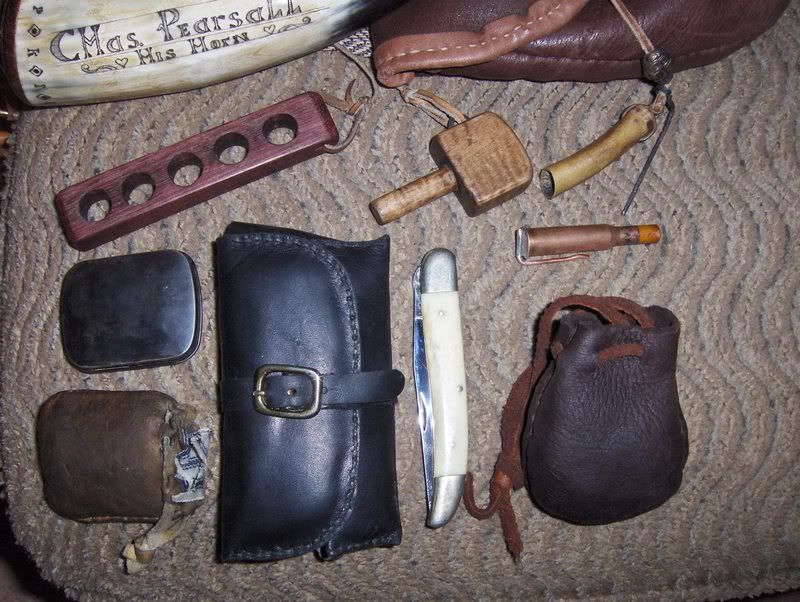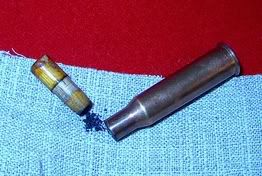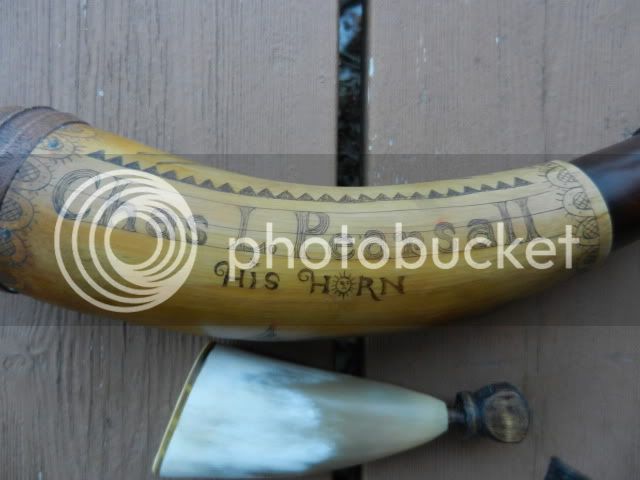Can anyone direct me to some documentation showing short starters were being used during the 1825 to 1840 mountainman period?
-
This community needs YOUR help today. We rely 100% on Supporting Memberships to fund our efforts. With the ever increasing fees of everything, we need help. We need more Supporting Members, today. Please invest back into this community. I will ship a few decals too in addition to all the account perks you get.

Sign up here: https://www.muzzleloadingforum.com/account/upgrades -
Friends, our 2nd Amendment rights are always under attack and the NRA has been a constant for decades in helping fight that fight.
We have partnered with the NRA to offer you a discount on membership and Muzzleloading Forum gets a small percentage too of each membership, so you are supporting both the NRA and us.
Use this link to sign up please; https://membership.nra.org/recruiters/join/XR045103
You are using an out of date browser. It may not display this or other websites correctly.
You should upgrade or use an alternative browser.
You should upgrade or use an alternative browser.
Short Starter
- Thread starter Cutfingers
- Start date

Help Support Muzzleloading Forum:
This site may earn a commission from merchant affiliate
links, including eBay, Amazon, and others.
Nope.
Nothing has been found of actual documentation.
European yes, State side, No.
Sounds tough to beleive, but true, Nothing.
Nothing has been found of actual documentation.
European yes, State side, No.
Sounds tough to beleive, but true, Nothing.
Nope. There are old drawings showing target shooters using them in Europe LONG before that, but I think they were passing rare in the U.S. among folks who had to carry their shooting gear for weeks or months.
Seems I remember in Hanson's book a drawing of a shooting pouch once owned by Modena(sp?) out of Taos with a short starter. This is the only reference I know of.
So I assume that in order to seat the ball the patching materal was not nearly as tight as we use today so the ball could be seated with the thumb and then seated the remainder of the way with the ramrod.
Or maybe, coneing was a common practice.
Your thoughts!
So I assume that in order to seat the ball the patching materal was not nearly as tight as we use today so the ball could be seated with the thumb and then seated the remainder of the way with the ramrod.
Or maybe, coneing was a common practice.
Your thoughts!
I have a tapered ramrod, and gripping it 4" from the end and pushing hard is as much as I need to start a .530" ball with a 0.021" patch in my .54 (muzzle is not coned). More usually I use a 0.018" patch.
My .50 and .54 T/C have parallel rods, but I use a 0.018" patch in them. No short starter. I do have a little 1-1/2" stub attached to a ball block with a wang to push the patched balls into the muzzle. If it's cold and the patches are stiff I will resort to that.
My .50 and .54 T/C have parallel rods, but I use a 0.018" patch in them. No short starter. I do have a little 1-1/2" stub attached to a ball block with a wang to push the patched balls into the muzzle. If it's cold and the patches are stiff I will resort to that.
I'm going to have to re-mic my patches and the barrell as on my .54. With a .530 R/B and .018 ticking I could never get it started w/o a short starter.
The .54 has a Sharron (sp?) barrell and it could be it will mic out smaller than I have believed.
Keep the ideas coming as they are very helpful.
The .54 has a Sharron (sp?) barrell and it could be it will mic out smaller than I have believed.
Keep the ideas coming as they are very helpful.
So I assume that in order to seat the ball the patching materal was not nearly as tight as we use today so the ball could be seated with the thumb and then seated the remainder of the way with the ramrod.
Or maybe, coneing was a common practice.
Your thoughts!
Correct. Both. Very often when we think of how rifles were used 'back then' we envision only frontiersmen, trappers, etc. either chasing buffalo or running from injuns. However, in cities and settlements there were sport shooters among the wealthier classes. Cased sets of firearms had a lot of, sometimes really neat, accessories. Among them were frequently short starters. To say they weren't used is too broad a brush.
Cutfingers said:Can anyone direct me to some documentation showing short starters were being used during the 1825 to 1840 mountainman period?
And by Mountain Man Period, and other references to thumb starting/coning, and your interest in revisiting your PRB sizes, etc (inferring the elimination of carrying unnecessary gear) I assume you're basically referring to typical Mountain Men, correct?
CORRECT

For those days when the lube is cold and stiff - or the batch of lead balls have more solder and antimony than desired. ;-)
Is that what that mysterious metal tube really is? I use[d] it for priming powder. Easier to pour from than the main horn. :redface: (And has since been replaced with a nice little flat priming horn).

That was just a temporary solution I stuck with for 20 years or so. The initial image shows one that has an added bit of wire soldered on to catch the lip of a pouch or the little sheath on my horn strap.

That was just a temporary solution I stuck with for 20 years or so. The initial image shows one that has an added bit of wire soldered on to catch the lip of a pouch or the little sheath on my horn strap.
Macon Due said:But...Stump, you said "No short starter. I do have a little 1-1/2" stub attached to a ball block with a wang to push the patched balls into the muzzle."...Isn't that "sorta" a short starter?
Macon :grin:
There are all kinds of 'short starters'. Some of mine have a short-short starter that pushes the ball only about a 1/4" below the muzzle. Then there is what I consider a normal short starter about 3" long. In some cases a long-starter
On the range I always use the short-short then cut my patch.
In the field I use only a 'normal' one, or none to start/seat the ball.
Comrade Coffin
40 Cal.
- Joined
- Jan 23, 2012
- Messages
- 206
- Reaction score
- 5
Good evening my friend, and a very nice set of clutter you have there.
I just made one tonight for my new 25 cal. I used some leftover ramrod bits and a piece of antler.
Going to the range for the first time with it this weekend. Have a range rod but needed something to get those little buckshot pellets started.
The one thing I didn't want to do was break my ramrod. Takes a long time to scrape and sand a 42 inch ramrod down to .23"
Going to the range for the first time with it this weekend. Have a range rod but needed something to get those little buckshot pellets started.
The one thing I didn't want to do was break my ramrod. Takes a long time to scrape and sand a 42 inch ramrod down to .23"
paulvallandigham
Passed On
- Joined
- Jan 9, 2006
- Messages
- 17,538
- Reaction score
- 79
You see guns( rifles) used in the 19th century West with coned muzzles- the other way( ie. thin patching and undersized balls) to eliminate the need for a short starter.
One has to doubt how long this situation lasted, since the movement West was both steady and on-going, through the first half of the century, ending with the Great Gold Rush in 1849. As more people moved West, more settlements and forts were built, and supplies became easier to obtain. The last rendezvous occurred in 1843, with a privately financed effort by William Drummond Stewart, but for all practical purposes, the last Organized rendezvous took place in 1838- just 14 years after the first one in 1825. The Forts were followed by railroads, and that construction really sped up during and immediately after the Civil War. The " Mountain Man" era was, really only a very short 14 years, and we stretch that by going back to 1807 when John Coulter left the Lewis and Clark Expedition to return to the mountains. Percussion ignition systems were being patented as early as 1807, but it took years for the manufacturers to perfect the process, and market reliable guns. Remember that Sam Colt got his patent for his first "Paterson revolver" in October, 1836, months after the fall of the Alamo that March. Those 5-shot, .36 cal. revolvers helped to change the history of Texas, and led to the development of more powerful,and stronger made revolvers. Better rifles were being developed in that late 1830s period, and on into the 1840's, and '50's.
What Hansen found was the lack of loops or pockets in hunting bags of that era to hold short starters, and, of course, the lack of short starters being saved with all the rest of the gear found with such bags.
The best one can say from the SURVIVING evidence is that it does not appear that "short starters" were popularly used by explorers, and trappers in that age- mountain men to us. There is a huge SILENCE in the writings of the day about short starters, when you read contemporary descriptions of the tools that MM took with them for their rifles.
I suspect that some of the lack of writings is due to the fact that by 1946, cartridges guns of sort began to appear, and in 1857, Smith and Wesson made and began selling their first cartridge revolvers.
The new " Breech loaders " were all the talk during this period, as they allowed the first revolutionary change in battlefield tactics in more than 300 years. Men could now take cover in trenches, and behind trees, and expose very little of their bodies to enemy fire when shooting the new guns. The new copper, and later brass, casings provided far better protection of the powder and components of ammunition than anything that had existed before, including percussion ignition. Repeating rifles and handguns gave the individual explorer, settler, or trapper a much better chance to survive an sudden attack by Indians.
Because of movies, we all tend to think of this period of our country's history as being more substantial and long lasting than it was. MOst of the people involved were not well educated and didn't write well. There simply are not a lot of written records surviving from that brief period that describes their lives. And, there was great hostility by the missionary, artists, and authors who did travel to the rendezvous, against the Mountain men, because they dressed, and associated with Indians more comfortably than with White people. When you do read histories, this class warfare becomes very apparent. The mountain men didn't take too kindly to the settlers, either, as they brought their religion and strange cultures from Europe or the East, and thought of themselves as superior to the men who had made it possible for the new people to live at all in these mountains. The MM were far outnumbered, and lacked the writing skills to make their case in the Eastern Press. They could not win.
We should not regret how little is left to read of that period, but marvel that anything survived at all. :shocked2: :v :hatsoff:
One has to doubt how long this situation lasted, since the movement West was both steady and on-going, through the first half of the century, ending with the Great Gold Rush in 1849. As more people moved West, more settlements and forts were built, and supplies became easier to obtain. The last rendezvous occurred in 1843, with a privately financed effort by William Drummond Stewart, but for all practical purposes, the last Organized rendezvous took place in 1838- just 14 years after the first one in 1825. The Forts were followed by railroads, and that construction really sped up during and immediately after the Civil War. The " Mountain Man" era was, really only a very short 14 years, and we stretch that by going back to 1807 when John Coulter left the Lewis and Clark Expedition to return to the mountains. Percussion ignition systems were being patented as early as 1807, but it took years for the manufacturers to perfect the process, and market reliable guns. Remember that Sam Colt got his patent for his first "Paterson revolver" in October, 1836, months after the fall of the Alamo that March. Those 5-shot, .36 cal. revolvers helped to change the history of Texas, and led to the development of more powerful,and stronger made revolvers. Better rifles were being developed in that late 1830s period, and on into the 1840's, and '50's.
What Hansen found was the lack of loops or pockets in hunting bags of that era to hold short starters, and, of course, the lack of short starters being saved with all the rest of the gear found with such bags.
The best one can say from the SURVIVING evidence is that it does not appear that "short starters" were popularly used by explorers, and trappers in that age- mountain men to us. There is a huge SILENCE in the writings of the day about short starters, when you read contemporary descriptions of the tools that MM took with them for their rifles.
I suspect that some of the lack of writings is due to the fact that by 1946, cartridges guns of sort began to appear, and in 1857, Smith and Wesson made and began selling their first cartridge revolvers.
The new " Breech loaders " were all the talk during this period, as they allowed the first revolutionary change in battlefield tactics in more than 300 years. Men could now take cover in trenches, and behind trees, and expose very little of their bodies to enemy fire when shooting the new guns. The new copper, and later brass, casings provided far better protection of the powder and components of ammunition than anything that had existed before, including percussion ignition. Repeating rifles and handguns gave the individual explorer, settler, or trapper a much better chance to survive an sudden attack by Indians.
Because of movies, we all tend to think of this period of our country's history as being more substantial and long lasting than it was. MOst of the people involved were not well educated and didn't write well. There simply are not a lot of written records surviving from that brief period that describes their lives. And, there was great hostility by the missionary, artists, and authors who did travel to the rendezvous, against the Mountain men, because they dressed, and associated with Indians more comfortably than with White people. When you do read histories, this class warfare becomes very apparent. The mountain men didn't take too kindly to the settlers, either, as they brought their religion and strange cultures from Europe or the East, and thought of themselves as superior to the men who had made it possible for the new people to live at all in these mountains. The MM were far outnumbered, and lacked the writing skills to make their case in the Eastern Press. They could not win.
We should not regret how little is left to read of that period, but marvel that anything survived at all. :shocked2: :v :hatsoff:
:redface:
That was a temporary solution . . . and it's been such for the last 25 years or so.
But I did just get a great little flat priming horh from Horner75.

That was a temporary solution . . . and it's been such for the last 25 years or so.
But I did just get a great little flat priming horh from Horner75.

Similar threads
- Replies
- 1
- Views
- 331
- Replies
- 5
- Views
- 663
- Replies
- 1
- Views
- 538
- Replies
- 1
- Views
- 366



